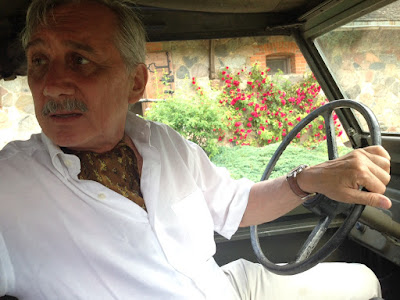Click on to enlarge - superior rendition
Battle of Waterloo by the Irish artist Willian Sadler (1782?-1839)
As everyone certainly knew, the bicentenary of the Battle of Waterloo fell on Thursday June 18th and was extensively commemorated throughout Europe, although possibly rather lower key in France.
In lieu of visiting Belgium (where the battle was re-enacted and the drivers enjoy a deserved reputation) I felt I should moot the idea of a CCC Waterloo Dinner. It was the least we could do in memory of the Iron Duke and his victory over Napoleon.
The history of Europe may well have been rather different had the outcome of this battle been otherwise. As we also all know it was ‘the nearest run thing you ever saw in your life’.
Perhaps in Bonapartist Poland sympathies lie in a different direction. He contributed many fine things to the country not least the Code Napoléon legal system. Napoleon was considered a hero, a bulwark against Russia, the embodiment of la gloire. His valiant personal bodyguard known as the Chevaux-Légers Polonais, placed Polish cavalry at the very apex of élan, spirit and horsemanship in Europe. Napoleon was considered a military genius to be emulated despite his opportunism towards the country and heartlessness towards the beautiful and loyal Marie Walewska who made the ultimate sacrifice in the name of patriotism.
The Waterloo Dinner was held at the Pod Gigantami Restaurant in Warsaw on the evening of June 18. I felt it appropriate to celebrate the confrontation here of two giants of European history - Wellington and Napoleon. Initially I had thought of the historic Zajazd Napoleonski but it was further out of town.
The House Pod Gigantami ('Under the Giants') where we had the Waterloo Dinner is situated in Ujazdowskie Avenue 24, part of the Royal Way in Warsaw.
It was built between 1904 and 1907 by Władysław Marconi.
The original interior was preserved during WW II as it had the function of a
Nazi Officers' Club.
Blazej Zulawski arriving at Pod Gigantami in the Ferrari to be greeted by the Chairman
The dinner was excellent and a convivial atmosphere was quickly established. Some new members of the club were welcomed.
Not quite this Waterloo Banquet held some time after the victory but we tried!
The Waterloo Banquet 1836 for 83 diners of the military persuasion by British artist
William Salter (1804-1875)
Rather later than anticipated I began my brief account of the complex preparations and Battle of Waterloo. I shall not go into any detail here. Suffice to say I covered the main elements as they unfolded on the day.
A rare daguerreotype photograph of the Duke of Wellington at 75
The Duke of Wellington on 'Copenhagen' by
Sir Thomas Lawrence (1769-1830)
Portrait of Napoleon by
Jacques-Louis David (1748-1825)
I find the contrast of these two portraits most instructive in terms of personality and style.
In order to accomplish this in an 'infotainment' manner (not to be overly serious following dinner) I used as a basis of my presentation excerpts from the television play Sharpe's Waterloo based on the novel by Bernard Cornwell.
I began with an account of the famous Duchess of Richmond's Ball.
The Duchess of Richmond's Ball by Robert Alexander Hillingford (1828-1904)
Battle of Ligny 16 June 1815 where Napoleon defeated Field Marshall Gebhard Leberecht von Blücher who used this windmill as his headquarters
British artist Ernest Crofts (1847-1911)
Intelligence arrives of the Blücher defeat at the Duchess of Richmond's Ball
I then covered the Battle of Quatre-Bras between Wellington's Anglo-Dutch army and the left wing of the Armée du Nord under Marshal Michael Ney. This battle was fought near the strategic crossroads of Quatre-Bras on 16 June 1815, two days before the Battle of Waterloo. Wellington only just managed to hold Napoleon here and retired to the village of Waterloo. Some months before the actual battle at Waterloo, Wellington had already planned to fight in this location and had had accurate maps of the terrain drawn up beforehand. This pre-planning gave him a distinct advantage.
The 28th Regiment at the Battle of Quatre Bras by the British painter Elizabeth Thompson (1846-1933). She is one of the few female painters to achieve fame through history painting.
Troop dispositions at Quatre-Bras and Ligny about 3.00 pm on June 18
(Waterloo by Tim Clayton, London 2014)
Battle of Waterloo: initial dispositions (Waterloo by Tim Clayton, London 2014)
Polish Lancer Unit attacking a British Square at Waterloo
Factually their participation is possibly somewhat fanciful. Polish soldiers contributed to the Battle of Waterloo
as part of the French Imperial Guard, particularly as lancers. While many
Poles returned to Polish territories after Napoleon's initial defeat, a unit of
around 325 men, including those under Colonel Golaszewski, continued fighting
in Napoleon's "Hundred Days" campaign and participated in the Battle
of Waterloo. These Polish cavalrymen, known for their bravery and skill,
were part of the prestigious Old Guard.
Waterloo at Close of Day by by Robert Alexander Hillingford (1828-1904)
* * * * * *
To the relief of some, our brilliant snapper Blazej Zulawski then gave us a tour of the highlights he photographed at the 2015 Villa d'Este Concours d'Elegance
Here are a few photographs of the assembled company at Pod Gigantami late on the night during his presentation
And a small selection of some hundreds of Blazej's photographs we were shown
(some identification captions to come)
Polish WW II General Sikorski's magnificent 1937 Rolls-Royce Phantom III with coachwork by Vanvooren of Paris
The Waterloo Dinner was a rather long but highly enjoyable evening with excellent food, wine and convivial CCC company.
CCC members present at this dinner:
Iain Batty
Ian Booth
Jacek Czeczot-Gawrak
Michael Moran
Michael Motz
Blazej Zulkawski
Guy Pinsent
Michael Wrobel
Jonathan Bowring
Mirek Staniszewski
Artur Gabor
Robert Windmill
Janusz Zawada
Paul Ayre, Paul Blackman, Neil Crook, Erik Hallgren, Edward Mier-Jędrzejowicz, Bill Flint, Michael Kenny sent their apologies.
Ladies present:
Basia Adam
Agata Zawada
Ladies present:
Basia Adam
Agata Zawada
Michael Moran (Chairman)
































































